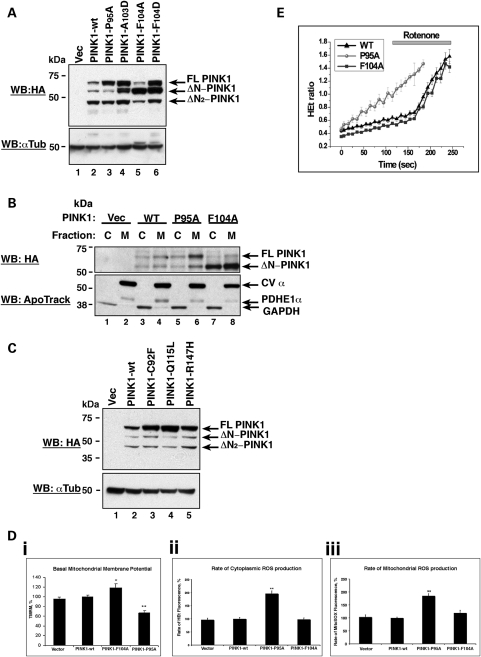Figure 2.
Efficient PINK1 cleavage is required for mitochondrial health. (A) Cleavage status of the PINK1 cleavage mutants compared with PINK1-wt. Vector control, PINK1-wt-3xHA, PINK1-P95A-3xHA, PINK1-F104A and PINK1-F104D constructs were expressed in SH-SY5Ys. Lysates were then assessed by WB analysis using an anti-HA antibody. (B) PINK1 cleavage mutants still localize to mitochondria. Vector control, PINK1-wt-3xHA, PINK1-P95A-3xHA and PINK1-F104A constructs were expressed in SH-SY5Y cells. Cell lysates were fractionated to isolate cytoplasmic and crude mitochondria. The presence of the PINK1 cleavage mutants in cytosolic and mitochondrial fractions was assessed by WB analysis using an anti-HA antibody. The membrane was subsequently re-probed with anti-ApoTrack cocktail which demonstrates the purity of the fractions and equal loading. (C) Cleavage of the N-terminal PINK1 PD mutant proteins. SH-SY5Y lysates expressing PINK1-C92F, PINK1-Q115L and PINK1-R147H constructs were analysed by WB with an anti-HA antibody. (D) (i) The cleavage status of PINK1 has important effects on basal mitochondrial membrane potential. Failure to cleave the PINK1 protein efficiently, shown through expression of the PINK1-P95A mutant, induces a significant reduction in mitochondrial membrane potential and makes cells more susceptible to stress-mediated death. Vector-transfected control cells were taken to be 100%. *P< 0.05 and **P< 0.005. (ii) A reduced ability to cleave PINK1 results in a significant increase in basal cytoplasmic ROS production. Basal ROS production in vector-transfected control cells was taken as 100%. **P< 0.005. (iii) Impaired PINK1 processing additionally results in a significant increase in basal mitochondrial ROS production. Basal ROS production in vector control-transfected cells was taken as 100%. **P< 0.005. (E) Assessment of ROS production in the PINK1-P95A and PINK1-F104A cleavage mutants compared with PINK1-wt. Basal ROS production increases over time in cells expressing the PINK1-P95A mutant without any stimulus. Stimulation of ROS production using rotenone to block complex 1 function has no effect on ROS production in PINK1-P95A cells but dramatically increases ROS production in both PINK1-wt and PINK1-F104A cells.

